Kia Sportage: Forward Collision-Avoidance Assist malfunction and limitations
Forward Collision-Avoidance Assist malfunction

- Check Forward Safety system
When Forward Collision-Avoidance
Assist is not working properly, the warning
message will appear, and the ( )
and (
)
and ( ) warning lights will appear
on
the cluster.
) warning lights will appear
on
the cluster.
Forward Collision-Avoidance Assist disabled

- Forward Safety system disabled.
Camera obscured
When the front windshield where the front view camera is located is covered with foreign material, such as snow or rain, it can reduce the detecting performance and temporarily limit or disable Forward Collision-Avoidance Assist.
If this occurs the warning message, and
the (
 ) and (
) and (
 ) warning lights will
appear on the cluster. Forward Collision-
Avoidance Assist will operate normally
when snow, rain or foreign material is
removed. Always keep it clean.
) warning lights will
appear on the cluster. Forward Collision-
Avoidance Assist will operate normally
when snow, rain or foreign material is
removed. Always keep it clean.
If Forward Collision-Avoidance Assist does not operate normally after obstruction (snow, rain, or foreign material) is removed, have the vehicle inspected by an authorized Kia dealer.
WARNING
- Even though the warning message or warning light does not appear on the cluster, Forward Collision-Avoidance Assist may not properly operate.
- Forward Collision-Avoidance Assist may not properly operate in an area (e.g. open terrain), where any substance are not detected after turning ON the vehicle.
Limitations of Forward Collision- Avoidance Assist
Forward Collision-Avoidance Assist may not operate normally, or it may operate unexpectedly under the following circumstances:
- The detecting sensor or the surroundings are contaminated or damaged
- The temperature around the front view camera is high or low due to surrounding environment
- The camera lens is contaminated due to tinted, filmed or coated windshield, damaged glass, or sticky foreign material (sticker, bug, etc.) on the glass
- Moisture is not removed or frozen on the windshield
- Washer fluid is continuously sprayed, or the wiper is on
- Driving in heavy rain or snow, or thick fog
- The field of view of the front view camera is obstructed by sun glare
- Street light or light from an oncoming vehicle is reflected on the wet road surface, such as a puddle on the road
- An object is placed on the dashboard
- Your vehicle is being towed
- The surroundings is very bright
- The surroundings are very dark, such as in a tunnel, etc.
- The brightness changes suddenly, for example when entering or exiting a tunnel
- The brightness outside is low, and the headlamps are not on or are not bright
- Only part of the vehicle, pedestrian or cyclist is detected
- The vehicle in front is a bus, heavy truck, truck with a unusually shaped luggage, trailer, etc.
- The vehicle in front has no tail lights, tail lights are located unusually, etc.
- The brightness outside is low, and the tail lamps are not on or are not bright
- The rear of the front vehicle is small or the vehicle does not look normal, such as when the vehicle is tilted, overturned, or the side of the vehicle is visible, etc.
- The front vehicle's ground clearance is low or high
- A vehicle, pedestrian or cyclist suddenly cuts in front
- The vehicle in front is detected late
- The vehicle in front is suddenly blocked by a obstacle
- The vehicle in front suddenly changes lane or suddenly reduces speed
- The vehicle in front is bent out of shape
- The front vehicle's speed is fast or slow
- The vehicle in front steers in the opposite direction of your vehicle to avoid a collision
- With a vehicle in front, your vehicle changes lane at low speed
- The vehicle in front is covered with snow
- You are departing or returning to the lane
- Unstable driving
- You are on a roundabout and the vehicle in front is not detected
- You are continuously driving in a circle
- The vehicle in front has an unusual shape
- The vehicle in front is driving uphill or downhill
- The pedestrian or cyclist is not fully detected, for example, if the pedestrian is leaning over or is not fully walking upright
- The pedestrian or cyclist is wearing clothing or equipment that makes it difficult to detect as a pedestrian or cyclist
The illustration below shows the image
the front view camera will detect as a
vehicle, pedestrian and cyclist.
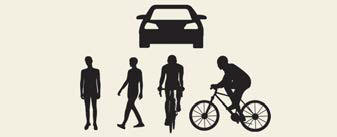
- The pedestrian or cyclist in front is moving very quickly
- The pedestrian or cyclist in front is short or is posing a low posture
- The pedestrian or cyclist in front has impaired mobility
- The pedestrian or cyclist in front is moving intersected with the driving direction
- There is a group of pedestrians, cyclists or a large crowd in front
- The pedestrian or cyclist is wearing clothing that easily blends into the background, making it difficult to detect
- The pedestrian or cyclist is difficult to distinguish from the similar shaped structure in the surroundings
- You are driving by a pedestrian, cyclist, traffic signs, structures, etc. near the intersection
- When driving in the following places
- Driving through steam, smoke or shadow
- Driving through a tunnel or iron bridge
- Driving in large areas where there are few vehicles or structures (i.e. desert, meadow, suburb, etc.)
- Driving in a parking lot
- Driving near areas containing metal substances, such as a construction zone, railroad, etc.
- Driving on an incline road, curved road, etc.
- Driving through a roadside with trees or streetlights
- Driving through a narrow road where trees or grass are overgrown
- There is interference by electromagnetic waves, such as driving in an area with strong radio waves or electrical noise
- The adverse road conditions cause excessive vehicle vibrations while driving
- Your vehicle height is low or high due to heavy loads, abnormal tire pressure, etc.
WARNING
- Driving on a curved road
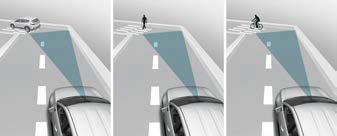 Forward Collision-Avoidance Assist
may not detect other vehicle, pedestrian
or cyclist in front of you on
curved roads adversely affecting the
performance of the sensors. This may
result in no warning or braking assist
when necessary.
Forward Collision-Avoidance Assist
may not detect other vehicle, pedestrian
or cyclist in front of you on
curved roads adversely affecting the
performance of the sensors. This may
result in no warning or braking assist
when necessary.
When driving on a curved road, you must maintain a safe braking distance, and if necessary, steer the vehicle and depress the brake pedal to reduce your driving speed in order to maintain a safe distance.
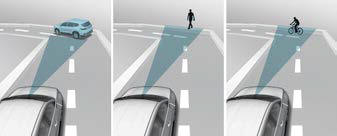 Forward
Collision-Avoidance Assist
may detect a vehicle, pedestrian or
cyclist in the next lane or outside the
lane when driving on a curved road.
Forward
Collision-Avoidance Assist
may detect a vehicle, pedestrian or
cyclist in the next lane or outside the
lane when driving on a curved road.
If this occurs, Forward Collision-Avoidance Assist may unnecessarily warn the driver and control the brake.
Always check the traffic conditions around the vehicle.
- Driving on a sloped road
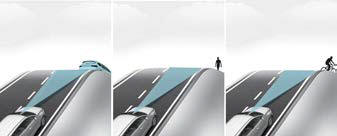 Forward Collision-Avoidance Assist
may not detect other vehicle, pedestrian
or cyclist in front of you while
driving uphill or downhill, adversely
affecting the performance of the sensors.
Forward Collision-Avoidance Assist
may not detect other vehicle, pedestrian
or cyclist in front of you while
driving uphill or downhill, adversely
affecting the performance of the sensors.
This may result in unnecessary warning or braking assist or no warning or braking assist when necessary.
Also, vehicle speed may rapidly decrease when a vehicle, pedestrian or cyclist ahead is suddenly detected.
Always have your eyes on the road while driving uphill or downhill and if necessary, steer your vehicle and depress the brake pedal to reduce your driving speed in order to maintain a safe distance.
- Changing lanes
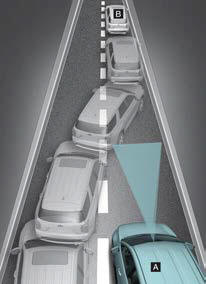 [A]: Your vehicle, [B]: Lane changing
vehicle
[A]: Your vehicle, [B]: Lane changing
vehicle
When a vehicle (B) moves into your lane from an adjacent lane, it cannot be detected by the sensor until it is in the sensor's detection range. Forward Collision-Avoidance Assist may not immediately detect the vehicle when the vehicle changes lanes abruptly. In this case, you must maintain a safe braking distance, and if necessary, steer your vehicle and depress the brake pedal to reduce your driving speed in order to maintain a safe distance.
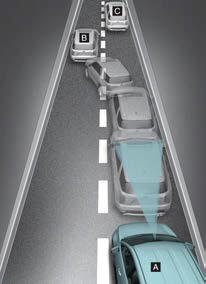 [A]: Your vehicle, [B]:
Lane changing
vehicle,
[A]: Your vehicle, [B]:
Lane changing
vehicle,
[C]: Same lane vehicle
When a vehicle (B) in front of you merges out of the lane, Forward Collision- Avoidance Assist may not immediately detect the vehicle (C) that is now in front of you. In this case, you must maintain a safe braking distance, and if necessary, steer your vehicle and depress the brake pedal to reduce your driving speed in order to maintain a safe distance.
Detecting a vehicle
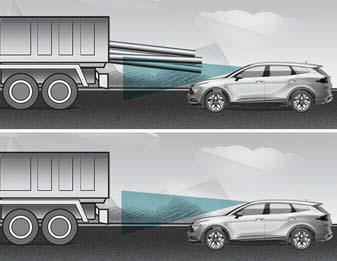 If the vehicle in front
of you has cargo
that extends rearward from the cab,
or when the vehicle in front of you has
higher ground clearance, additional
special attention is required. Forward
Collision-Avoidance Assist may not be
able to detect the cargo extending
from the vehicle. In these instances,
you must maintain a safe braking distance
from the rearmost object, and if
necessary, steer your vehicle and
depress the brake pedal to reduce
your driving speed in order to maintain
distance.
If the vehicle in front
of you has cargo
that extends rearward from the cab,
or when the vehicle in front of you has
higher ground clearance, additional
special attention is required. Forward
Collision-Avoidance Assist may not be
able to detect the cargo extending
from the vehicle. In these instances,
you must maintain a safe braking distance
from the rearmost object, and if
necessary, steer your vehicle and
depress the brake pedal to reduce
your driving speed in order to maintain
distance.
WARNING
- When you are towing a trailer or another vehicle, we recommend that Forward Collision-Avoidance Assist is turned off due to safety reasons.
- Forward Collision-Avoidance Assist may operate if objects that are similar in shape or characteristics to vehicle, pedestrian or cyclist are detected.
- Forward Collision-Avoidance Assist does not operate on bicycles, motorcycles, or smaller wheeled objects, such as luggage bags, shopping carts, or strollers.
- Forward Collision-Avoidance Assist may not operate normally if interfered by strong electromagnetic waves.
- Forward Collision-Avoidance Assist may not operate for 15 seconds after the vehicle is started, or the front view camera is initialized.
This device complies with Part 15 of the FCC rules.
Operation is subject to the following three conditions:
- This device may not cause harmful interference, and
- This device must accept any interference received, including interference that may cause undesired operation.
- Changes or modifications not expressly approved by the party responsible for compliance could void the user's authority to operate the device.
Radio frequency radiation exposure information:
This equipment complies with FCC radiation exposure limits set forth for an uncontrolled environment. This equipment should be installed and operated with minimum distance of 8 inches (20 cm) between the radiator (antenna) and your body. This transmitter must not be colocated or operating in conjunction with any other antenna or transmitter.
READ NEXT:
 Forward Collision-Avoidance Assist (FCA) (Sensor Fusion)
Forward Collision-Avoidance Assist (FCA) (Sensor Fusion)
Basic function
Forward Collision-Avoidance Assist is
designed to help detect and monitor the
vehicle ahead or help detect a pedestrian
or cyclist in the roadway and warn
the driver that a col
 Forward Collision-Avoidance Assist settings
Forward Collision-Avoidance Assist settings
Setting features
Forward Safety
Driver Assistance
Forward Safety
Active Assist
Warning Only
Off
With the vehicle on, select Settings?
Driver Assistance ? Forward Safety
f
 Forward Collision-Avoidance Assist operation
Forward Collision-Avoidance Assist operation
Basic function
The basic function for Forward Collision-
Avoidance Assist is warned and controlled
by the following level.
Collision Warning
Emergency Braking
Stopping vehicle and ending br
SEE MORE:
 Bulb replacement precaution
Bulb replacement precaution
Light bulbs are installed in various parts
of the vehicle to provide lighting inside
and outside the vehicle as well as to alert
other vehicles.
Bulb replacement precaution
Please keep extra bulbs on hand with
appropriate wattage ratings in case of
emergencies.
Refer to "Bulb wattage&
 Disassembly - Replacing body panel
Disassembly - Replacing body panel
Disassembly
1. Body measurement
Before disassembling, measure the damaged area
according to the dimensions supplied in Body
Dimension, Section 31. If deformation is present,
use a frame straightener to adjust.
When disassembling a panel, apply clamps to
prevent damage of each part, an
Content
- Home
- Kia Sportage - Fifth generation (NQ5) - (2022-2025) - Owner's Manual
- Kia Sportage - Second generation (JEKM) (2005-2015) - Body Workshop Manual
- Kia Sportage Third generation (SL) - (2011-2016) - Service and Repair Manual
- Sitemap
- Top articles